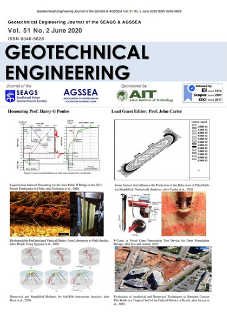Liquefaction Induced Downdrag for the Juan Pablo II Bridge at the 2010 Maule Earthquake in Chile
Main Article Content
Abstract
Sandy soil layers reduce volume during and following liquefaction, which results in settlement of the overlying soil layers. In case of pile constructed in the liquefying soil, the liquefaction-induced settlement induces downward directed shear stress (negative skin friction) along the pile causing the pile to settle—be dragged down. Depending on the site conditions, the change in the axial response resulting from liquefaction-induced settlement, and downdrag can have a significant impact on piled foundation performance in seismic regions. This study presents an analytical method to quantify the effects of liquefaction-induced downdrag on drilled shafts. The method relies on combining two diagrams. One diagram shows the distributions of force along the pile in negative and positive direction displaying a force equilibrium. The other diagram shows the distribution of soil and pile movement, displaying a settlement equilibrium. The analysis method consists of combining the force movement of the pile and the soil so that the two equilibriums occur at the same depth, called the “neutral plane”. The method, called the “unified analysis method”, is applied to an observed case of downdrag during the February 7, 2010, Maule Magnitude 8.8 earthquake in Chile showing that the calculated settlements are close to those observed at the site. The results of the unified analysis indicate that the major effect on the pile settlement was from liquefaction-induced settlement below the pile toe level, as opposed to downdrag. The case study shows the importance of combining forces and movements in the analysis of piled foundation settlement.
Article Details

This work is licensed under a Creative Commons Attribution-NonCommercial-NoDerivatives 4.0 International License.
Copyright © 2019 Association of Geotechnical Societies in Southeast Asia (AGSSEA) - Southeast Asian Geotechnical Society (SEAGS).


